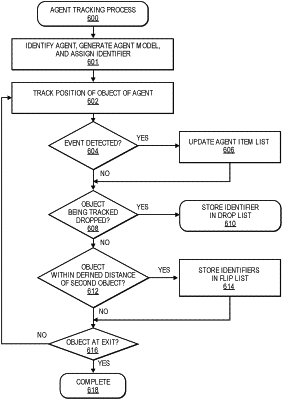| CPC G06V 20/52 (2022.01) [G06F 18/22 (2023.01); G06V 10/74 (2022.01); G06V 10/751 (2022.01); G06V 40/103 (2022.01); G06V 40/166 (2022.01); G06V 40/168 (2022.01); G06V 40/172 (2022.01); G06V 40/23 (2022.01)] | 20 Claims |

|
1. A computer implemented method, comprising:
receiving first image data from at least one camera of a plurality of cameras within a materials handling facility, wherein the first image data includes a representation of at least a portion of a first agent;
generating, based at least in part on the first image data, a first agent model corresponding to at least a portion of the first agent;
tracking a position of an object corresponding to the first agent as the object moves around within the materials handling facility;
during the tracking, determining that the position of the object has been dropped;
in response to determining that the position of the object has been dropped, adding a first object identifier corresponding to the object to a drop list; and
subsequent to adding the first object identifier to the drop list:
determining a second agent model representative of at least a portion of a second agent;
determining that the second agent model corresponds to the first agent model; and
in response to determining that the second agent model corresponds to the first agent model, associating the first agent model with a second object that is being tracked, wherein the second agent model is generated based at least in part on the second object.
|